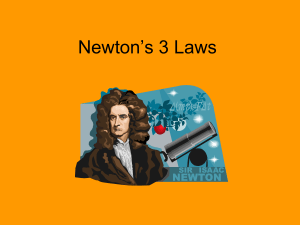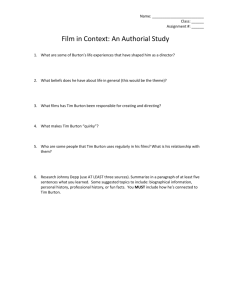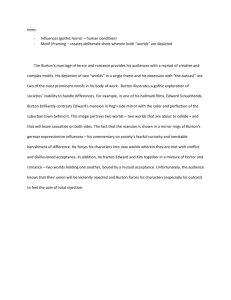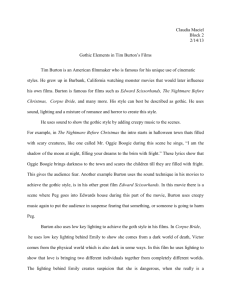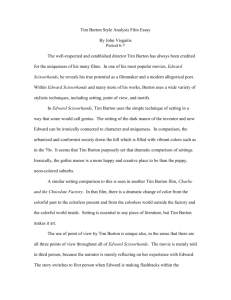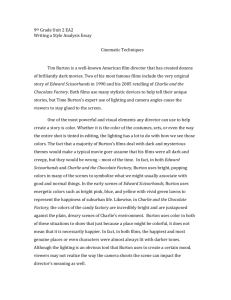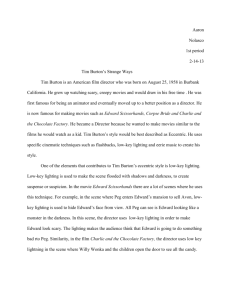Sample Essays for Unit 2 EA 2
advertisement
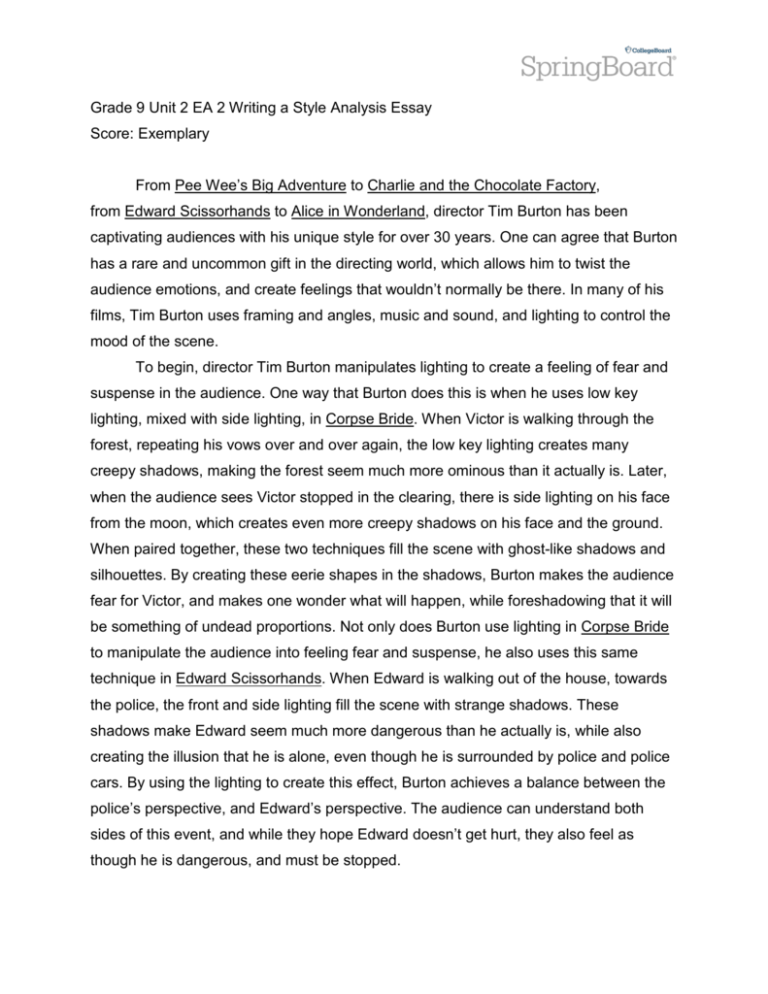
Grade 9 Unit 2 EA 2 Writing a Style Analysis Essay Score: Exemplary From Pee Wee’s Big Adventure to Charlie and the Chocolate Factory, from Edward Scissorhands to Alice in Wonderland, director Tim Burton has been captivating audiences with his unique style for over 30 years. One can agree that Burton has a rare and uncommon gift in the directing world, which allows him to twist the audience emotions, and create feelings that wouldn’t normally be there. In many of his films, Tim Burton uses framing and angles, music and sound, and lighting to control the mood of the scene. To begin, director Tim Burton manipulates lighting to create a feeling of fear and suspense in the audience. One way that Burton does this is when he uses low key lighting, mixed with side lighting, in Corpse Bride. When Victor is walking through the forest, repeating his vows over and over again, the low key lighting creates many creepy shadows, making the forest seem much more ominous than it actually is. Later, when the audience sees Victor stopped in the clearing, there is side lighting on his face from the moon, which creates even more creepy shadows on his face and the ground. When paired together, these two techniques fill the scene with ghost-like shadows and silhouettes. By creating these eerie shapes in the shadows, Burton makes the audience fear for Victor, and makes one wonder what will happen, while foreshadowing that it will be something of undead proportions. Not only does Burton use lighting in Corpse Bride to manipulate the audience into feeling fear and suspense, he also uses this same technique in Edward Scissorhands. When Edward is walking out of the house, towards the police, the front and side lighting fill the scene with strange shadows. These shadows make Edward seem much more dangerous than he actually is, while also creating the illusion that he is alone, even though he is surrounded by police and police cars. By using the lighting to create this effect, Burton achieves a balance between the police’s perspective, and Edward’s perspective. The audience can understand both sides of this event, and while they hope Edward doesn’t get hurt, they also feel as though he is dangerous, and must be stopped. Not only does Tim Burton use lighting to achieve a desired effect on the audience’s feelings, he also uses music and sound to mold the mood of the films. For example, Burton uses non-diegetic music in Charlie and the Chocolate Factory to emphasize the feelings of the children when they are let loose in the edible room. By using the music to explain the children’s thoughts and emotions, Burton allows the audience to gain a deeper understanding of the characters, and feel as though they are in the movie, not just watching it. This also allows the audience to experience the candy room through each of the children’s perspective, which creates a deeper connection between the character and the audience. Burton also uses non-diegetic music in Corpse Bride to again allow the audience into the character’s head. When Victor is running form the bride, Burton controls and changes the mood of the movie by using music when we first see the bride. As Victor rehearses his vows, there is a proud, almost triumphant feeling conveyed with sounding music, which allows the audience to understand how excited he is to have finally gotten them right. However, when Victor places the ring, unknowingly, on the bride’s figure the music changes to an ominous and frantic soundtrack, which made the mood of the audience go from happy for Victor, to scared for him as he runs from the bride. By changing the music and twisting the mood, burton allows the audience to know that Victor’s mood has changed as well. In addition to allowing the audience to gain a better understanding of the characters, Burton uses non-diegetic sound to foreshadow the events that are about to take place. A good example of this is in Edward Scissorhands. Near the end of the movie, Kevin is walking home from a friend’s house down the street, a seemingly average task. However, the ominous, non-diegetic music foreshadows the events that are about to take place are anything but average. When the audience sees the van speeding toward Kevin, one realizes that he is in danger, which was foreshadowed by the creepy music. By using this technique, Burton can create suspense in his films which would make the audience want to find out what will happen and therefore keep watching. Finally, director Tim burton uses framing and angles to again manipulate and change the mood of the film. A prime example of this is in Charlie and the Chocolate Factory. As Charlie stands outside of the factory, staring up at it, Burton uses a mixture of high and low angle to make Charlie seem small and the factory seem big. By using a low angle on the factory and a high angle on Charlie, Burton gives the feeling that Charlie feels week, powerless, and insignificant especially when he is compared to something as big and incredible as this world-renowned chocolate factory. Similarly, in Corpse Bride, Burton uses a low angle on the bride when she rises out of the ground. When the audience sees the bride from this angle, one can imagine how Victor sees her, and begins to feel frightened by her, because she appears so much larger than a normal sized person. It is not until later in the movie does one realize that she is actually an average-sized person. This effect is achieved because of the angle on the bride when the audience first sees her. Additionally, Burton uses a long shot in Edward Scissorhands when we see the mob of people enter the forest. By using a long shot, the audience can see both how many people there are, and their angry, almost crazed body language. When these two things are shown together in one shot, one can understand the gravity of the situation, and begins to fear for Edward’s life. Throughout all his films, director Tim Burton uses many film techniques and cinematic elements. However, when Burton wants to control the audiences’ emotions, and twist the mood of the scene, he uses lighting, non-diegetic music, and framing and angles to achieve the desired effect. By using his directing skills and combing these techniques, Burton creates incredible films that mesmerize people of all ages, and will enchant audiences for generations to come. Score: Exemplary Annotation An Exemplary literary analysis of style must be able to link Burton’s style to his use of cinematic techniques. The assertion that Tim Burton uses cinematic techniques to control the mood of the scene comes close to identifying a stylistic trait, though it is still fairly general. Extensive use of textual evidence of the effect of cinematic techniques from multiple films is a clear strength of this essay. Well-developed elaboration of the textual evidence and especially sophisticated transitional devices puts this exemplar firmly in the Exemplary proficiency band. The commentary enhances the specific evidence provided and is wide-ranging and insightful, showing a deep understanding of cinematic techniques and how they create specific effects in mood and atmosphere. The last paragraph brings the analysis to a satisfying and perceptive conclusion by returning to the central concept that Burton’s style is characterized by a desire to “control the audiences’ emotions, and twist the mood of the scene.” This control of the essay through organization and progression of ideas is supplemented by the precise use of cinematic vocabulary and generally sophisticated sentence structure and language. Grade 9 Unit 2 EA 2 Writing a Style Analysis Essay Score: Proficient Tim Burton, famously known for his movies that appeal to children with dark and haunting twists such as The Nightmare Before Christmas, Alice in Wonderland, Frankenweenie, and many others, uses a multitude of different cinematic techniques to create dramatic events to keep the audience entertained. Burton uses a series of sounds, lighting, and camera movements to do so. His classic, dream like films are unique and use these elements to bring the attention to the smaller, more important parts of the film. For starters, in both Charlie and the Chocolate Factory and Edward Scissorhands, we hear non-diegetic music being played during many scenes, giving viewers clues that something important is about to happen. For example, in Charlie and the Chocolate Factory, as Willy Wonka opens the doors to the candy field, we hear angelic like singing which helps us realize that the children and their parents are awestruck at the sight of all the chocolate and sugar. By using non-diegetic music like this, it helps the audience understand this piece of the film and also relate to a time when they were amazed by something as well. This was also used in Edward Scissorhands, where we hear non-diegetic music being played as Kim dances in the falling ice shavings of Edward’s ice sculpture. This sound helps signify the importance of the scene as it also answers the opening question posed by the granddaughter; where does the snow come from? Another cinematic technique Burton uses to create his movies is low key lighting. We see this being used in Corpse Bride multiple times. One of the biggest scenes that he used this in was when Victor is being chased by Emily after slipping the ring on her finger in the woods. With low key lighting, it creates the intensity of the scene and the darkness with the moon light creates eerie shadows. These shadows help the audience identify the setting as spooky and creepy. Burton also uses this in The Nightmare Before Christmas. As the scene opens up, low key lighting is used in the graveyard, illuminating the ghosts and skeletons. The lighting adds to the already seemingly dark movie with creepy characters and creatures. The way Burton uses lighting in the film creates mysterious shadows and glowing effects, adding to the depth of the movie and characters. Lastly, Burton uses a series of camera movements to show the viewers the characters and the settings. In Edward Scissorhands, when the scene where Kim and her friends are running out of the house and to the van, tracking is used to follow them. This makes the audience feel as if they are running in the movie as well. Another camera movement Burton uses is a crane in Edward Scissorhands. The crane is used as the grandmother began to tell her story and the camera flies out the window to go across the neighborhood and over to the castle. This not only shows us the setting of the neighborhood but also begins the flashback. By using these movements, we are able to get more knowledge on the movie and collect more details that play a big role in the film. Throughout his films, Burton uses multiple techniques to draw the viewer in. By using sounds, lighting, and camera movements, Burton creates a film that perfectly flows together and captures the audience’s attention and minds. His attention to small details and creative mind make the viewer feel as if they are in the movie. Score: Proficient Annotation: This high Proficient exemplar provides a clear identification and analysis of cinematic techniques and their effects, but exhibits a less clear understanding of how these cinematic elements can be used to characterize Burton’s style beyond the description of Burton’s films as “dream-like.” The discussion does display a strong understanding of the effects of Burton’s cinematic choices on the audience and the organization reflects an understanding of the structure of literary analysis. The essay does a particularly good job of providing textual evidence to support the analysis of effect from multiple sources. The textual evidence from the films and the accompanying commentary shows an insightful understanding of the effective use of cinematic techniques in creating mood and manipulating the audience’s attention. The tight organization enhances the discussion as does the use of transitions which creates clarity and cohesion. The use of language is especially laudable in its appropriate use of film and literary vocabulary to discuss stylistic devices. It is the lack of a strong connection between the analysis of cinematic techniques and a clear identification of Burton’s unique style that keeps this essay from being Exemplary. Grade 9 Unit 2 EA 2 Writing a Style Analysis Essay Score: Emerging Spooky, heartwarming, confusing, childish, amazing, all of these are adjectives describing directors Tim Burton’s cinematic style. Tim burton is a very creative and artistic director he has directed movies such as, Edward scissors hand, the nightmare before Christmas, Charlie and the chocolate factory, and Batman and these movie the director Tim Burton’s uses very unique stylistic techniques especially in his shots and framing, camera angles/movement, and sound. Tim burton does this so that he can achieve his desired effect on the audience. Tim Burton’s uses special cinematic style to achieve his desired effect on us, for example in the movie Edward scissor hands, in the beginning when peg first meets Edward, when peg walks in to the attic the director Tim burton uses the cinematic technique, long shot causing peg look small and tiny, and by doing this director Tim burton Is making us the viewer believe that peg is tiny, weak and vulnerable to what might be in the castle. Tim burton uses various cinematic techniques in his films from the shot to the type of music, but he uses them all for a specific reason. For instance in Edward scissor hands Tim burton uses non diegetic sound to set the mood in several occasions, for example when peg is going up the stairs in the beginning of the movie, and as she slowly goes up Tim burton uses non diegetic music to set the eerie and suspenseful tone making the viewer feel like something scary is about to happen. He also did this in another very popular movie Charlie in the chocolate factory, when Tim Burton shows us how Willie Wonka went to “Loompa Land” to find new exotic flavors for his candy, Burton uses non-diegetic dialogue so that the audience knows what is going on. In conclusion, Tim Burton is an amazing director who has a very unique cinematic style and uses various creative cinematic techniques to make the audience feel his desired effect. Score: Emerging Annotation: The opening of this Emerging exemplar shows that the writer has an understanding of the prompt and the relationship between style and cinematic effect. The thesis is adequate, though it does not approach proficient because the thesis lacks a statement that characterizes Burton’s overall style and its relationship to cinematic techniques. The exemplar also contains textual evidence from two different films that show an understanding that cinematic techniques create specific effects. Unfortunately, this understanding is not enhanced by the organization of the essay. The first body paragraph is one long run-on sentence that does address the prompt, but is only one piece of textual evidence. The next paragraph does a better job of addressing the prompt, but again the topic sentence fails to identify the “specific reason” that would characterize Burton’s style. The conclusion is only adequate. The use of transitions shows an understanding of their importance in order to achieve coherence, but they are only adequate. The exemplar uses the language of cinematic vocabulary with some precision, but one final problem is that errors in sentence structure distract from meaning throughout. Grade 9 Unit 2 EA 2 Writing a Style Analysis Essay Score: Incomplete Not for the faint hearted, be prepared for this spine tingling tale, which will keep you on your seat! Gripped in a vice of fear, as I relate you the story of the most influential American film producer, who has been terrifying his audience for decades, to the point of sheer cruelty. Ladies and Gentlemen, I give you Tim Burton famous for his weirdest, and creepiest movie yet, Edward Scissorhands. Tim was born on August 25th, 1958 in Burbank, California. Burton was an outcast and he was always told that he wasn’t normal. He thought normal was playing in a cemetery at night, and he always got told by his teacher that his drawings were not normal, but he didn’t see anything wrong with them. In 1994, Burton casted Johnny Depp as the title character in Edward Scissorhands. It took place in Ed Wood-a blackand-white portrait of a middling filmmaker. I think what Tim is trying to say is that you’re not supposed to judge people by what they like to do, and what they like to listen to! In Edward Scissorhands, Edward learns that if you do something wrong, then people will judge you. The theme of the movie that Tim is using is that different is a good thing. Like Charlie and the Chocolate factory, Charlie and Edward both get judged. Charlie is not the richest kid, and he isn’t the most spoiled kid, but Charlie knows that he has his family and that means so much more to him than being rich, or being spoiled, and being the center of attention. Just because he lives in the outskirts of a really big nice city. So no one should be getting judged for what they have. Like, you could be on your own like Edward and you could feel like living in town with other people could be a strange thing to do, but Charlie thinks living in an old broken house is good, because he knows he still has his family. In Charlie and the chocolate factory the music is very intriguing and it really shows what the town looks like. Score: Incomplete Annotation Despite the engaging, rather dramatic lead-in to this essay, the overall score of this essay rests firmly in the Incomplete proficiency band based on its organization and lack of focus. From the beginning, the introduction presents an insufficient, incomplete thesis by introducing a film for discussion without any focus on identifying and analyzing Tim Burton’s style as a director. The next paragraph might be better used as part of the introduction; it is not relevant to a discussion of the director’s cinematic style. The main support paragraph is focused on a thematic statement without any reference to style which should be the focus of the essay. It is not until the last sentence that the essay turns to a cinematic element. Overall, though the essay does not rest on summary, it does not address the analysis prompt. The lack of focus on director’s style is also reflected in the lack of any vocabulary of literary or cinematic style. A generally adequate command of the conventions of language does not move this essay out of the incomplete proficiency band.

